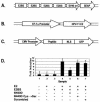Identification of peptides that inhibit the DNA binding, trans-activator, and DNA replication functions of the human papillomavirus type 11 E2 protein
- PMID: 14963172
- PMCID: PMC369253
- DOI: 10.1128/jvi.78.5.2637-2641.2003
Identification of peptides that inhibit the DNA binding, trans-activator, and DNA replication functions of the human papillomavirus type 11 E2 protein
Abstract
Peptide antagonists of the human papillomavirus type 11 (HPV-11) E2-DNA association were identified using a filamentous bacteriophage random peptide library. Synthetic peptides antagonized the E2-DNA interaction, effectively blocked E2-mediated transcriptional activation of a reporter gene in cell culture, and inhibited E1-E2-mediated HPV-11 DNA replication in vitro. These peptides may prove to be useful tools for characterizing E2 function and for exploring the effectiveness of E2-inhibitor-based treatments for HPV-associated diseases.
Figures



Similar articles
-
Peptides inhibitory for the transcriptional regulatory function of human papillomavirus E2.Clin Cancer Res. 2003 Nov 1;9(14):5423-8. Clin Cancer Res. 2003. PMID: 14614029
-
A fifteen-amino-acid peptide inhibits human papillomavirus E1-E2 interaction and human papillomavirus DNA replication in vitro.J Virol. 1998 Oct;72(10):8166-73. doi: 10.1128/JVI.72.10.8166-8173.1998. J Virol. 1998. PMID: 9733858 Free PMC article.
-
Human TATA binding protein inhibits human papillomavirus type 11 DNA replication by antagonizing E1-E2 protein complex formation on the viral origin of replication.J Virol. 2002 May;76(10):5014-23. doi: 10.1128/jvi.76.10.5014-5023.2002. J Virol. 2002. PMID: 11967317 Free PMC article.
-
Inhibition of human papillomavirus DNA replication by small molecule antagonists of the E1-E2 protein interaction.J Biol Chem. 2003 Jul 18;278(29):26765-72. doi: 10.1074/jbc.M303608200. Epub 2003 Apr 30. J Biol Chem. 2003. PMID: 12730224
-
Targeting human papillomavirus genome replication for antiviral drug discovery.Antivir Ther. 2013;18(3):271-83. doi: 10.3851/IMP2612. Epub 2013 Apr 24. Antivir Ther. 2013. PMID: 23615820 Free PMC article. Review.
Cited by
-
A Novel, Broad-Acting Peptide Inhibitor of Double-Stranded DNA Virus Gene Expression and Replication.Front Microbiol. 2020 Nov 17;11:601555. doi: 10.3389/fmicb.2020.601555. eCollection 2020. Front Microbiol. 2020. PMID: 33281801 Free PMC article.
-
Control of Viral Latency by Episome Maintenance Proteins.Trends Microbiol. 2020 Feb;28(2):150-162. doi: 10.1016/j.tim.2019.09.002. Epub 2019 Oct 14. Trends Microbiol. 2020. PMID: 31624007 Free PMC article. Review.
-
Discovery and Characterization of Peptide Inhibitors for Calcium and Integrin Binding Protein 1.ACS Chem Biol. 2020 Jun 19;15(6):1505-1516. doi: 10.1021/acschembio.0c00144. Epub 2020 May 26. ACS Chem Biol. 2020. PMID: 32383857 Free PMC article.
References
-
- Alexander, K. A., and W. C. Phelps. 1996. A fluorescence anisotropy study of DNA binding by HPV-11 E2C protein: a hierarchy of E2-binding sites. Biochemistry 35:9864-9872. - PubMed
-
- Alexander, K. A., and W. C. Phelps. 2000. Recent advances in diagnosis and therapy of human papillomaviruses. Expert Opin. Investig. Drugs 9:1753-1765. - PubMed
-
- Barker, D. F., and A. M. Campbell. 1981. The birA gene of Escherichia coli encodes a biotin holoenzyme synthetase. J. Mol. Biol. 146:451-467. - PubMed
-
- Bhardwaj, D., S. S. Singh, S. Abrol, and V. K. Chaudhary. 1995. Monoclonal antibodies against a minor and the major coat proteins of filamentous phage M13: their application in phage display. J. Immunol. Methods 179:165-175. - PubMed
-
- Brown, B. M., and R. T. Sauer. 1993. Assembly of the Arc repressor-operator complex: cooperative interactions between DNA-bound dimers. Biochemistry 32:1354-1363. - PubMed
Publication types
MeSH terms
Substances
Grants and funding
LinkOut - more resources
Full Text Sources
Other Literature Sources

